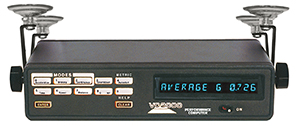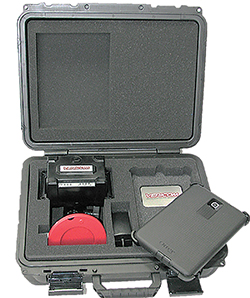
By Richard Tackett with reporting by David Hubbard
Vericom LLC has been providing precise, easy-to-use engineering test systems for 35 years.
In 1984, Roger McCumber, along with fellow ‘hot rod’ and drag-racing enthusiasts, wanted to create a device to test the speeds of performance cars and motorcycles. That lead to the development of one of the very first electronic accelerometers.
“Once Roger developed the accelerometer, his fellow car enthusiasts started asking for devices of their own,” said Todd Schaeffer. “So Vericom started as a business focused on hot-rod enthusiasts.”
 This led to the creation of the VC200 – Vericom’s first commercialized motion and vehicle performance testing system.
This led to the creation of the VC200 – Vericom’s first commercialized motion and vehicle performance testing system.
Over time, users of the system pointed out to McCumber that Vericom’s precision test computers would work well in other fields. It stood to reason that if the Vericom system could measure an object’s speed, it could also measure an object’s braking capability and deceleration. Eventually, Vericom testing systems became commonplace in the police forensics field and runway friction testing.
In the 1990s, the VC200 evolved into the Vericom VC2000 and then again into the VC3000. The VC3000 included the addition of an advanced graphing and analysis tool that allowed users to review the details of their test data. Today, the Vericom VC4000 Brake Meter and VC4000 family of precision test instruments have seen widespread adoption in public transportation for its accuracy, simplicity, and affordability in determining vehicle braking capability as compliance to Federal and State regulations.
 Breaking into transit
Breaking into transit
It was the company’s initial expansion into police and law enforcement which precipitated its entry into the public transportation market, Schaeffer said.
“Many of the police inspectors using the technology were also commercial vehicle inspectors,” he said. “Our entry into the public transit market was a direct result of those end-users’ prior experience with our product.”
Per Section §393.52 of the Federal Motor Carrier Safety Act, when testing brake performance, any motor vehicle must be capable of stopping from 20 miles per hour within a designated distance. The customers required to comply with that regulation needed a simple, affordable, high-performance brake meter, Schaeffer said.
The Vericom VC4000 Brake Meter mounts easily to a vehicle via suction cup, and brake testing is  activated by pressing two buttons. Each test on the meter takes about 10 seconds. Upon completion, the display screen immediately notifies the driver whether the vehicle’s brake system passed or failed.
activated by pressing two buttons. Each test on the meter takes about 10 seconds. Upon completion, the display screen immediately notifies the driver whether the vehicle’s brake system passed or failed.
“Our customers do not need a lot of extraneous information,” Schaeffer said. “They’re interested in whether their vehicles passed or failed based on the Federal and State standards.”
The system assesses a vehicle’s stopping distance and braking rate (which is also known as the deceleration rate). Testing with a Vericom unit can also indicate when a braking system is ready to for replacement or service.
Vericom’s transit business expanded throughout the 1990s, and the early- to mid-aughts saw the Vericom VC4000 Brake Meter and VC4000 PC become the adopted standards for testing brake performance across the U.S. – including for standardized commercial vehicle testing in New York and New Jersey.
“Our transit business really grew when New York, New Jersey, parts of California, Texas, and some of the other states with the bigger transit organizations started to adopt Vericom technology,” Schaeffer said.
In addition to public transit agencies, Vericom’s family of products are also widely used by several Departments of Transportation across the country. For example, the Midwest Roadside Safety Facility of Lincoln, Nebraska, uses the VC4000 DAQ, often utilized in accident reconstruction, in full-scale crash tests of roadside safety devices.
 The products also see notable use at the New York Department of Transportation, Jacksonville’s Institute of Police Technology and Management, and the Northwestern University Traffic Institute in Evanston, Illinois.
The products also see notable use at the New York Department of Transportation, Jacksonville’s Institute of Police Technology and Management, and the Northwestern University Traffic Institute in Evanston, Illinois.
As the company grew, it added the sensors needed to test more the complicated motion that occurs in buses, trolleys, and trains. Some newer transit buses have large batteries mounted to their roofs. For roof-mounted battery applications, transit engineers and maintenance professionals need a tool that can easily test the ‘side’ rotation a bus may experience when a large weight, such as a battery, on the roof of the bus.
“We are proud that Vericom provides the solution for these new needs,” Schaeffer said. “As vehicles develop, the technology surrounding them needs to advance as well.”
More sophisticated analysis software, and the ability to connect pressure sensors to the Vericom test systems, were also added in recent years.
1984: Roger McCumber and fellow ‘hot rod’ enthusiasts develop one of the first electronic accelerometers.
1990s: Vericom products become popular with law enforcement agencies, which used the brake meters for accident reconstruction.
2000s: Transit agencies begin adopting Vericom technology due to its accuracy and easy-to-use design.
2019: Vericom continues to innovate, enhancing its product family to better meet its customers’ needs.
 Setting the standard
Setting the standard
Schaeffer said the key to the Vericom product family’s success is not only the devices’ precision, but the fact that they can reduce complex problems into simple solutions.
“We provide technical engineering test systems that are simple and easy to use,” he said. “The Vericom units are intended for the professional that needs the answer quickly and avoid unnecessary data. Other similar test systems dump all the data on the user with no assistance in providing the answer needed.”
“We’re proud that our customers say, ‘It’s easy, it works when I need it to work, and it gives me accurate information,’” he added.
Looking ahead, Schaeffer said that Vericom’s plans for the future are to continue serving its customers with sophisticated engineering and test systems that are easy to use and provide consistent results they can trust.
“When we talk to customers, we always try to solve their problems with a tool that is easy to use and delivers the test results that are clear and understandable,” he said.
As an example, Schaeffer pointed to a feature on the company’s latest V-SenseTM product: the pass/fail user setting. He explained that many transit customers need to achieve a certain braking deceleration rate when testing brake systems. To further simplify the process, Vericom introduced the new setting so a user can standardize the pass/fail limit. After a test is competed, the operator will quick see a green or red screen to indicate whether a vehicle passed.
“That seems like it’s such a simple thing, but it’s a big deal to the operator,” Schaeffer said. “We try to take our customers’ technical issues and make them practical, by asking ourselves, ‘Can we add some sort of feature, sensor, or capability that continues to simplify their lives?’”
